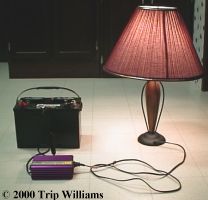
*Solar Power, Our Evolution*
I won't bog you down in details in this article since all of the technical info can be found in my other articles on solar and alternate energy... This article is simply about our evolution from depending solely on the commercial power grid, to the solar grid we have today. If you want more details, you can find em in the Alpha Way Section or Alternate energy section of the Rubicon... this article assumes you have already read those articles and/or understand common power-related concepts, terminology and safety guidelines.
Sometime back in early 2001 We figured out that the power lines out here in the country SUCK. Constant "blinks", Brown-outs and down right outages started us looking for a better way to insure power to our home than at the whim of our finicky power company.
We were tired of constantly resetting the clocks and TV channels in our home.. it was getting ridiculous. We KNOW when it's 5:45 AM, cause at 5:45 AM every morning our power blinks out just long enough to restart the computers and make us reset the clocks.
The obvious answer was UPS (Uninterruptable Power Supply) units. We had a few for the computers but the batteries weren't the best in the world. Also, during the winter if we get ANY snow or ice at all here in Upstate South Carolina, you can bet the power is going out to stay for a while.
We solved this problem by taking the batteries out the UPS units and connecting the battery wires to deepcycle 12 volt, 115 A/H batteries (27DC-6 Batteries from Wal-Mart, actually) So we had a Deepcycle battery, a UPS unit and a small inverter we usually keep in the Vehicles.

Of course it wasn't long after that before we needed a bigger UPS unit.. and since the ones we were given were 24V UPS units we needed two deepcycles for each one...
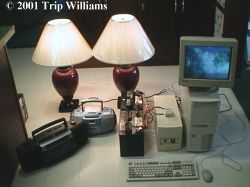
All well and good... We could run a few items for a few hours.. so immediately a storm hit and that's about all we had, which meant a trip to Home Depot to buy a generator since sitting around by lantern light is no fun unless you happen to be camping.
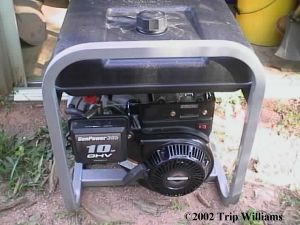
The problem with generators is the noise and that they need to be fed everyday (LOTS of Gasoline, which can be hard to come by especially if your supply is limited by something like the world falling apart).. still you can run a generator a LONG time if you are prepared to do it in advance. Of course, everyone within a mile knows you have power when they don't, cause they hear the noisy thing running.. that aint good... Of course, If you want to Quieten your Genset, it's easy to do.
We decided to try solar panels to extend the battery life on the UPS units. We bought one 21 watt thin film panel and wired it up.
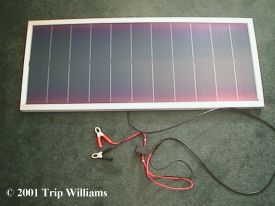
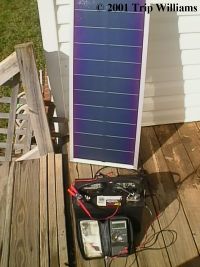
As you probably know, 21 watts at 12 volts only puts out 1.75 amps.. which is not a lot to try to keep a large deepcycle running. About the best we could do was extend the run time on our UPS unit, OR let the UPS battery charge a little during the day. Time for another Solar panel...
When you have TWO solar panels you need a rack to mount them in and a way to keep them pointing at the sun. Another thin film was in our future, as was a lot of welding and cutting to make racks.
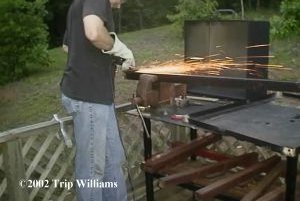
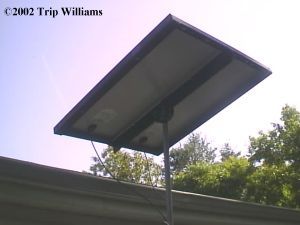
Still, 42 watts isn't enough to do anything serious, and buying low wattage panels one at a time is EXPENSIVE! The "Price per watt" is way up there when compared to the higher wattage panels.
By now, we had several large deepcycle batteries and a small charge controller. We bit the bullet and got a Siemens SP-75, 75 watt panel.. this meant that we now needed a larger charge controller since our small MorningStar "SunGuard" was only rated at 10 amps and we planned to get more panels as we could afford them... we got a MorningStar "SunSaver-20", and sold the "SunGuard".
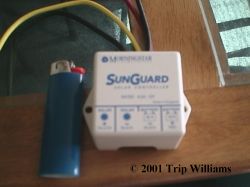
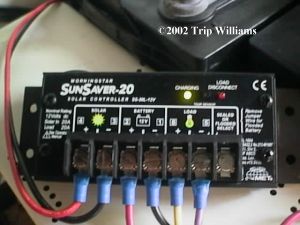
At this point we were a bit more comfortable with our emerging system. 9.75 amps is nothing to sneeze at (Or so we thought at the time).
Have I mentioned that our Power Company supplies us power at one of the cheapest rates in the country? Well it does... and as aggravating as it can be it is still cheaper than solar panels and the various batteries and support equipment.
I mention the above because we never intended to "Get off the grid"... the commercial grid is cheap! All we wanted to do by now was carry us through the blinks and short outages that occur. We figured on being able to run a few lights, a small Radio and TV and such for a few hours and then let the sun take it's time and charge the batteries back up... HAH!
A Rubicon member we know is another Solar enthusiast, and he knows a dealer that sells Siemens Solar panels. It seems that Shell bought out Siemens, and by 2003 all of the stock of Siemens panels had to have "Shell" printed on them instead of the time honored "Siemens" logo. Needless to say, dealers were cutting good deals on these panels to try to move them before the deadline of 2003. So many members of the Rubicon got together and bought up several pallets (About $22,000 worth) of them from this member's dealer. They trucked them to our door in a semi-trailer and we redistributed them out to the other Rubicon members... since then we've done another Rubicon Group buy and bought even MORE panels, but I'll get to that further below.
Suddenly we were ahead in panels and behind on Batteries and charge controllers! The 20 amp SunSaver seemed like a lot of amperage when we bought it, but when you have a kilowatt of panels, it aint... trust me. We took a deep breath and bought two Trace C-40 Charge controllers... these larger units can handle 40 amps a piece and can be configured to handle 12 Volts, 24 volts or 48 volts OR be used as a "load control unit" (which is important for Wind generators, which we are starting to play around with now ;). We plan to swap everything over from our current 12VDC system to a 24 volt DC system soon, so we needed the flexibility that the Trace C40 offered... we've since bought SEVERAL of these C-40's from http://www.affordable-solar.com/affordablesolar/. You can find em cheaper elsewere maybe, but these folks have always done us right and are VERY courteous and fast.
Why swap to a 24 volt system? Simple electronics. I = P/E
Consider this, 1000 watts (P) divided by 12 volts (E) = 83.333 amps (I)! Let's give it the respect it deserves, "EIGHTY THREE POINT THREE THREE THREE AMPS"... BIG WIRE, multiple charge controllers! Consider that same 1000 watts at 24 volts which equals only 41.66 amps! Instead of two C40 charge controllers in 12 volt mode, we can use ONE C-40 in 24 volt mode (Even though we run 2 C-40's since we plan to keep expanding our system). Also our wires don't have to carry as much current and things run smoother and cooler.
Either way, Things were starting to get serious... that's a lot of amperage in anyone's book, and we needed TWO Trace C40's to run at 12 volts... these had to be wired up with welding cables!
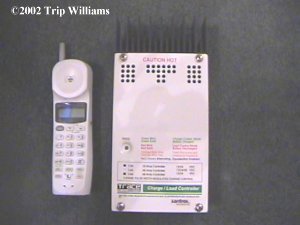
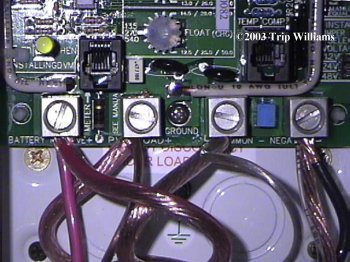
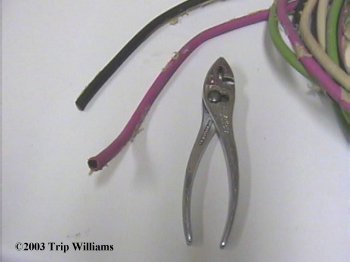
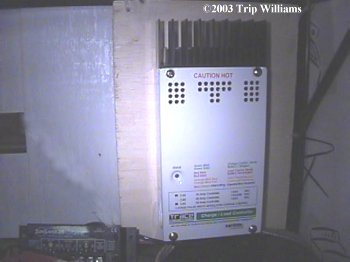
As I said, we realized suddenly that we were starting to play in the realm of the big boys now. What started out as a small, Modular "can be added-on to", stop-gap system was now taking on a life of it's own. We had to find a LOT of room to place the panels where they'd get sun all day, we needed more than an ad-hoc battery system... we needed organization.
Still, we wanted this system to be transportable since we are looking at newer houses with more land. We have 10 acres, but we'd rather not be able to see a neighbor at all. So how do you place a couple of kilowatts of solar panels so that they are easy to move later???
You go "up" to the roof. Our roof gets sun all day since we live on a southern facing hill top. When the sun clears the horizon in the morning, it hits our roof and does so until late in the evening when our woods start blocking off the setting sun. Actually, we split the difference and put some panels on our roof, more on our Shop roof, and we left the smaller thin films in their rack on a pole.
Suddenly everything in the house that was on "back up power" could be shifted to solar only.
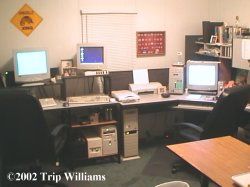
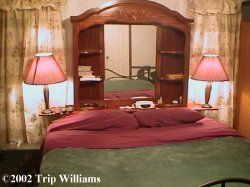
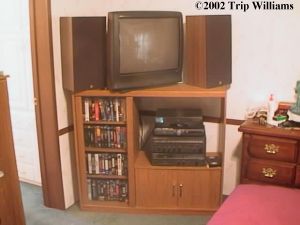
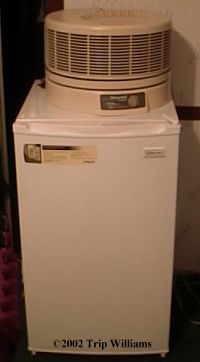
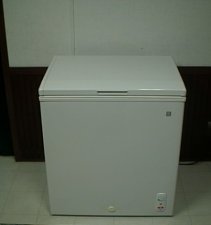
Let me interject here that "lights" were what was killing us on power. when you run two 60 watt bulbs in each room, the wattage QUICKLY adds up. To combat this hogishness we swapped to the new fluorescent compact bulbs for lights in the house on the solar grid that stayed on a lot.. this has freed up a LOT of power for other things.
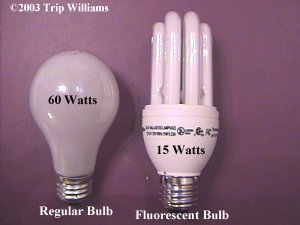
We'd already run alternate power receptacles to various points in the house so that anything plugged into them wouldn't go off if the power blinked out.. the other end of these receptacles was hooked to large, centrally located, UPS units and batteries... when the sun was out, the UPS batteries looked to solar to charge their batteries, if the sun wasn't out the UPS units would recharge the batteries from commercial power... We took those existing power lines and simply connected them to the Solar Only grid.
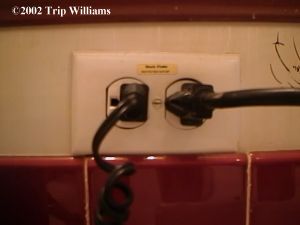
But I'm getting ahead of myself here.. first we had to get the panels up on the roof. That SOUNDS easy.. but it's not. It was a problem until I found out that a twin bed frame we were throwing away would hold 3 panels PREFECTLY. We had two of these frames to discard, so we welded them both together and lifted the frame up to the roof of the shop (see the article on bed-frames for solar panels in the Alpha Way section)
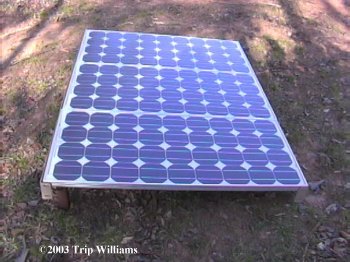
I showed the girls how to wire panels in parallel, so while they were stringing the panels together on the roof, I built the battery boxes and ran the main wires to the Trace Charge Controllers, and ran venting hoses to vent battery fumes.
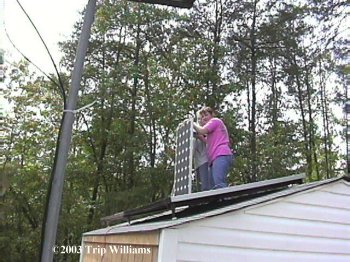
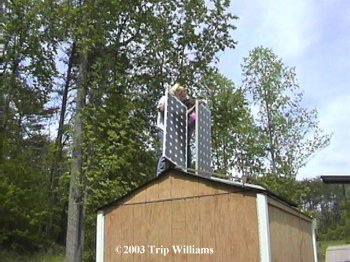
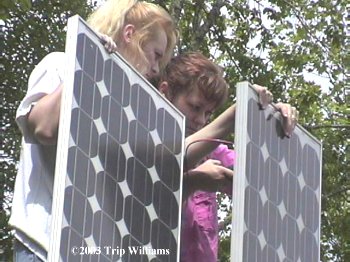
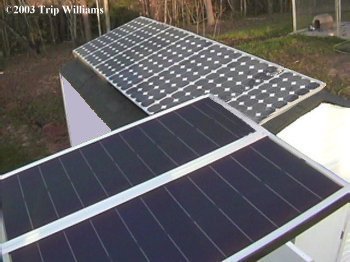
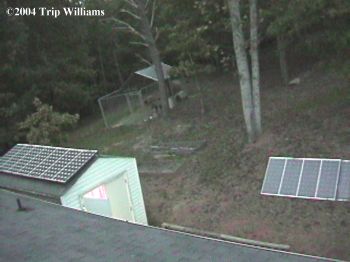
(Updated 24 September 2004)
Our Camper has six solar panels on it from the latest Group Buy, and a stand-alone solar grid of it's own, Complete with Trace C-40 Charge Controller and Batteries. Since the Camper sits a lot, we also tied in the Camper's Solar Grid to our Home's solar grid. The Camper has a plug-in that now mates to a solar-only receptacle on the outside of the house. This gives us 464 more amps of Batteries and 450 Watts of Solar panels to add to the total the house's Alt-Power grid can handle.
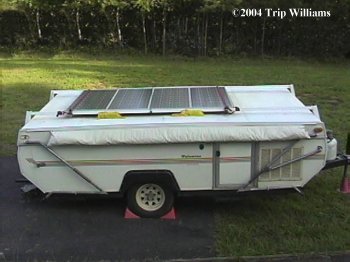
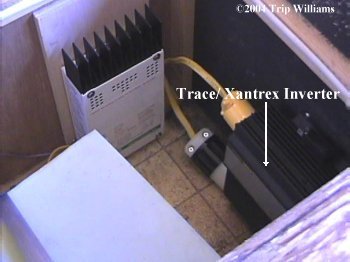
The Battery boxes in the house were simple.. I braced under the bottom shelf of a metal shelf rack with 2x4's and then ran plywood around the outside of the batteries to make a compartment. The lid fits on top to keep battery fumes out of the house, and a small sparkless computer fan kicks on every 30 minutes to pull out any built up fumes or gas. The lid is easy to remove so that I can check the battery bank's water every month. Each bank holds five 12V, 115 A/H deepcycle batteries.
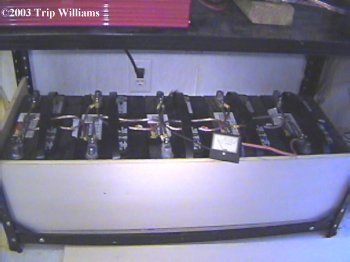
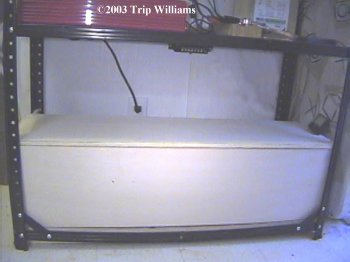
The Trace handbook says the "Group 27" series of batteries are fine to use for Alt Energy purposes... We primarily use the 27DC-6 models, but we're looking for more Trojan Batteries at a decent price since they are bigger and specifically designed for Alt energy systems... of course they are specifically a lot more expensive too ;)
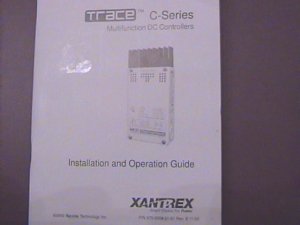
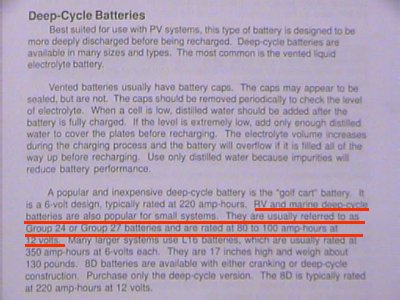
Converting, inverting, and other stuff
Having done all this, we now needed to convert that DC power to AC. That aint as easy as it seems.. and it can be as costly as the panels you already bought. THERE IS A DIFFERENCE in inverters.. this is a confusing topic and rated a whole article in itself (see the Alpha Way section).. We needed a "good" inverter. A cheap inverter will burn up your equipment if you aren't careful. We saved a little money here (luckily) by cheating....
... A friend of ours gave us a 1500 Watt inverter that contained Siemens Mosfets (look it up).. these are good transistors and can handle being filtered on the input AND the output. The Inverter had a bad transformer in it, but this was easily replaced. Then I took the Modified Sine wave the inverter produced and rounded off the top and bottom of the wave and smoothed out the inclines using pass filters I made on breadboard. The wave looked good and I seemed to hit an RMS value of .707 (which is all you can expect from the power company). Then I put a computer on the inverter and let it run for 3 days. This computer pings the atomic clock in Boulder Colorado over the internet and automagically adjusts the system clock... I turned off the atomic pinger and let the computer run.. when I pinged the atomic clock again in three days I had lost only 3 seconds!!!! I can live with that, and it means my cycles and wave are pretty darn close to what the power company is giving me... It felt so good to me that I did the same thing to a UPS unit AND a smaller inverter we use for lamps and such ;)
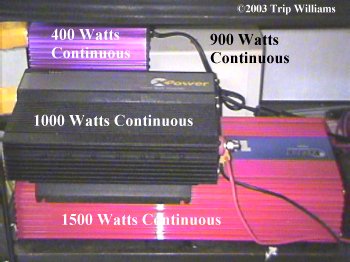
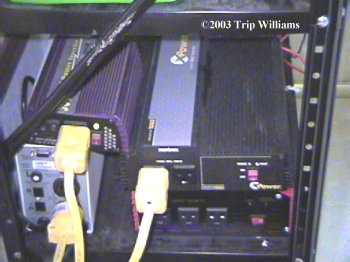
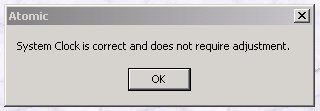
(Before you bother to ask, No, I'm not putting the filter circuit online, I'm NOT buying anyone a new inverter cause they tried to build a filter and messed it up... If you're interested, I'm sure that similar plans are out there somewhere)
Of course you need a way to hook the inverters to the batteries. Since I expect our grid to evolve further as time goes on, I didn't want to do anything permanent to the connections yet. I made a terminal block out of a 2x4, some center insulators and some heavy terminal lugs.. and then used heavy rounded Alligator clamps to connect the inverters to the terminal lugs.. it worked out better than I hoped and will hold us until I get the docking center completed (which I'm working on).
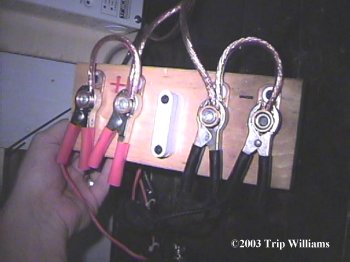
The #10 Wire shown above has since been replaced by Welding leads. This allows us to pull upwards of 175 amps from the batteries if needed.
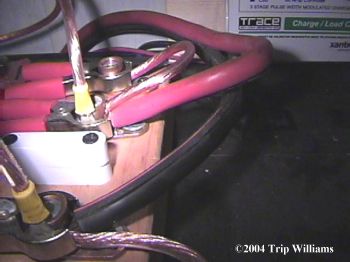
My Docking center will have screw lug terminals on it, as well as the Voltage and amperage meters.... Right now I meter total battery voltage, charging amperage and load amperage. I'll pretty this up some and build it into the docking center.
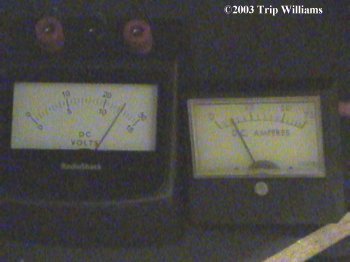
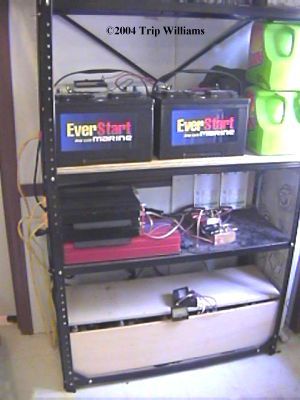
The above values are where we're sitting right now after two very rainy days and continuous usage of the batteries.. for this computer and some lights etc we pull about 11-13 amps.. when everything is running I've seen the system demand 60 amps (Gulp) all total, but we were stress testing it at the time.. in theory we can pull 175+ amps out of it on a sunny day using several Trace Charge Controllers.. but I don't want to go there ;)
Totals
Most everyone wants to know the totals.. How much total power do you produce? How many batteries do you have? How much did it cost? etc, etc, etc,
The first two questions are easy. We have 1963 watts of panels (closer to 2kw actually), and about 17 kW of batteries (Ten 27DC-6 Deepcycle batteries and 4 Trojans on another circuit).
Cost is very much harder to figure accurately since we scrounged some stuff, got deals on some other stuff (including the group panel purchase), traded for some stuff and then made mistakes and had to re-buy bigger or better equipment.. not to mention the costs of Wire, Terminals, busses, Romex, plugs, yada yada yada yada... It aint cheep, let me tell ya, but remember that we've been working on this for well over three years. I'd say the total cost of the panels was about $7,500 bux and about $900 in batteries. Add to that $350.00 bux in Charge controllers and if I had to buy the inverters and stuff about 700-800 bux there counting both inverters and 4 UPS units. We probably have another 250 bux in Wire and terminals... let's call it $9,700 or there-about. Spread out over the 3.5 years we've been working on it the cost breaks down to about $230 a month... that cost drops daily now though since the Solar Setup is almost paid for, and we ARE saving quite a bit on our power bill now each month. But consider this, if you and your spouse both quit smoking, you can buy a solar system and STILL come out a few bux a month to the good!
Obviously it'll take a few years for the envisioned "Final System" to pay for itself completely, but it will eventually. Our power bill has dropped considerably, so that helps offset the cost per month of the system, and every month we get a little more of our investment back in the form of lower power bills.
UPDATE: 28 December 2005
As I predicted above, our system paid for itself earlier this year in power bill savings. By reading this article you can follow our long term plan and see how we "got off the grid" (Which, again, we didn't plan to do in the beginning).
When our Solar Power System paid for itself, we applied that power bill savings toward buying our first True-Sinwave "Outback inverter".. we bought a model VFX3524 (3500 watts, 120VAC, 24VDC input). This Inverter is THE top of the line, and can be combined with a second Outback Inverter to produce 240VAC. When our Savings from the power bill equal the cost of a second Outback, we'll purchase that also (Which should happen even faster now that our power bills will drop considerably).
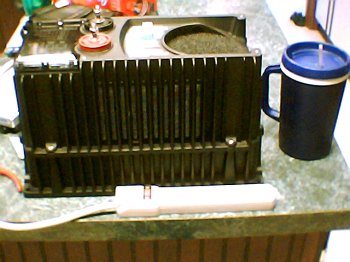
When the Outback arrived, we swapped the wiring on our Siemens Solar panels and our 12V batteries so that they were all in "Series/Parallel", and wired the Outback into the Solar Alt Power Grid. Since we used Anderson Power Poles for all our wiring connections when we set up our system, it only took about 30 minutes to swap the wiring so our 12VDC system was converted into a 24VDC system (We planned on this, which is why we used the Anderson Power Poles while setting everything up, and why we bought batteries and panels in even numbers).
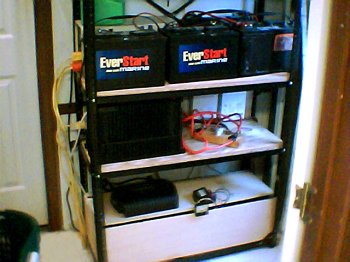
The only thing connected to Commercial Grid Power at this point is our HVAC unit, Water heater, and Stove (Basically the 240VAC equipment).
When the HVAC unit shuts off, the Commercial Power Meter Wheel outside STOPS.
It costs about 30 Bux a month just to keep the Commercial Grid Power connected, whether we use any Commercial power or not, so right now we use that 30 dollar minimum to run our 240VAC equipment... That's a FAR cry from 200+ bux a month on average (again, our Home is total electric).
We recently put our Solar power system to the test.. the recent ice storm here in SC took out power to the entire Upstate area.. we were without commercial power for a bit over 3 days (Many people were without power for WEEKS)... we barely even noticed. We were able to live normally, and even attend my Grandmother's funeral (with 5 people taking hot showers and 4 girls using blow dryers and curling irons). We ran the house from our Solar power, and ran the 240VAC equipment from our Generator.
.. and THAT is our ultimate Goal as Rubies.. Not just to "Survive" in bad times, but to live as normally as possible in bad times. As I state in many articles, when TSHTF, it's NOT a time to drastically change your life style all of a sudden. If you can live normally in a disaster, you are WAY ahead of the sheeple! Going from a total Electric home, to living by primitive candle light, is NOT something that is conducive to survival. Society WILL pick back up when the disaster is over, and those of us that have lived "Normally" will be in a MUCH better financial position after it's over.
Actually, we messed up a bit since we accidentally left the porch lights on, and the whole rest of the area was without power. So we stood out a bit at first until other people in the area started running generators. When we realized our mistake, we turned off the outside lights and pulled our black-out curtains. Still, we had steak and shrimp dinners, and our freezer foods were never in danger since the freezers run on solar power... We watched a LOT of DVD's on our 57 inch High-Def TV... Still it was a comfort to have our Security System up and running on Alt Power during the "Silly season".. criminals were taking advantage of the power outage.. many homes were left unguarded as people went to Motels in Georgia to ride out the storm.
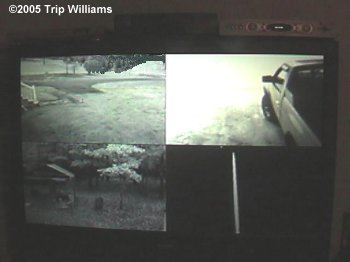
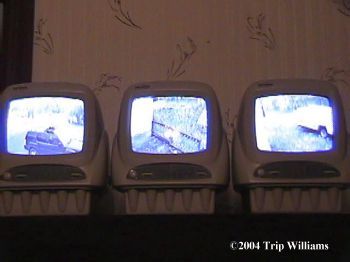
Now that we've gone to a 24VDC system, we have a bunch of 12VDC Xantrex inverters (Shown Above in this article) stacked in the storage building doing nothing. I planned the system in the beginning so we wouldn't have any waste as we added to the system, but this was inevitable. It's only about 300 dollars worth of inverters, and I'm sure we'll find a use for them again, maybe in the Camper as we expand it's solar capabilities.
Again, You simply need a realistic long term plan, and you need to stick to it. We basically planned the "Perfect System" and then got there step by step, always trying to think ahead so that each purchase would fit into the long term goal without waste... When planning the "Perfect System" for you, research is your friend!
So that's our unwitting evolution from a single battery and UPS unit to what we have today.
For the Completion of this article, where we take our Battery banks outside, and our Power-bill drops to ZERO..
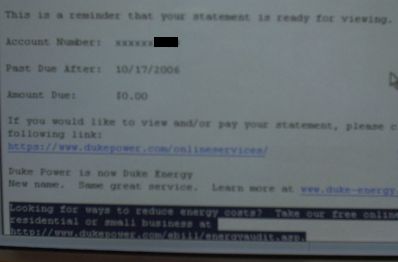
Click HERE
Warlord
All materials at this site not otherwise credited are Copyright © 1996 - 2005 Trip Williams. All rights reserved. May be reproduced for personal use only. Use of any material contained herein is subject to stated terms or written permission.